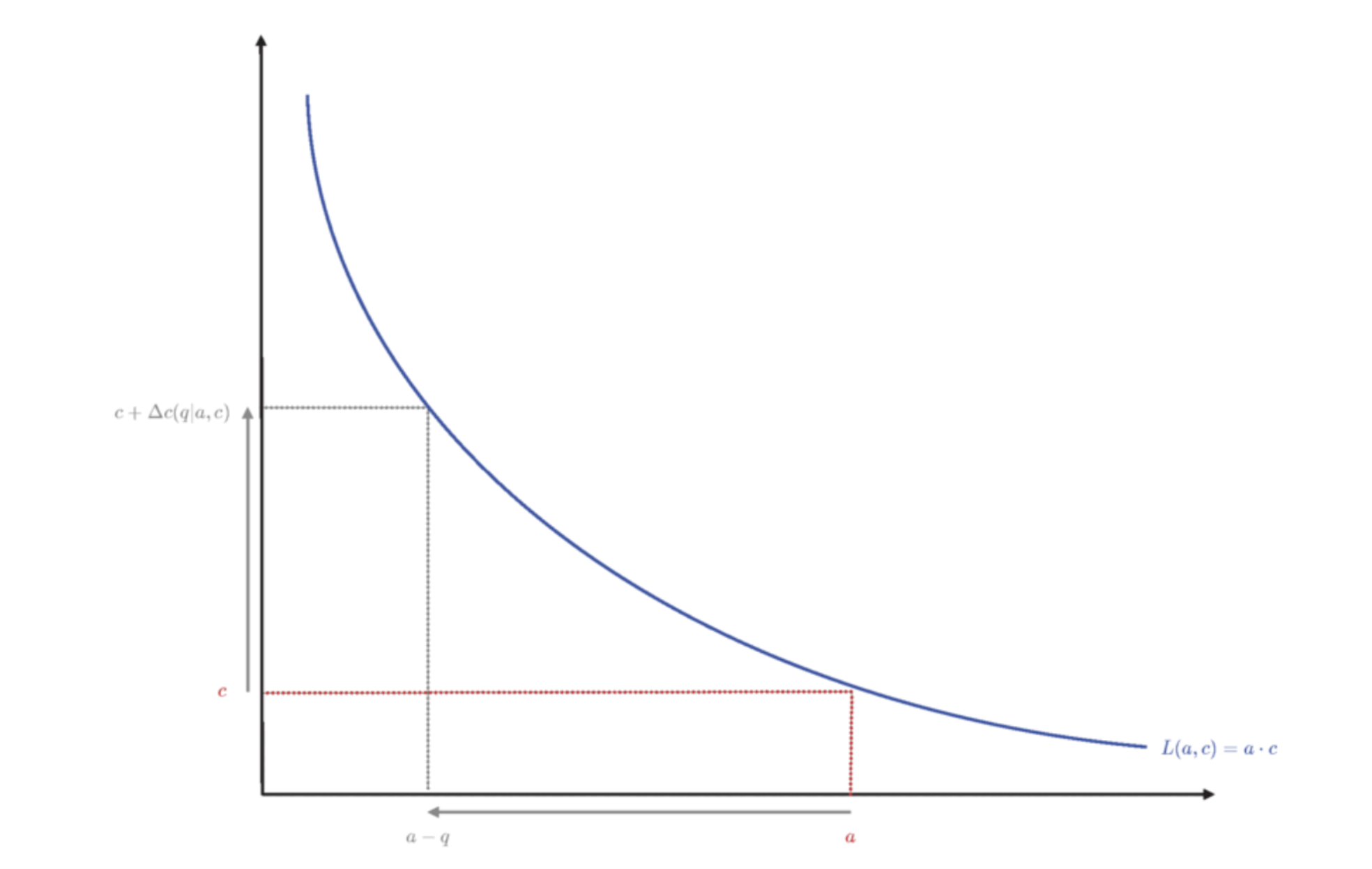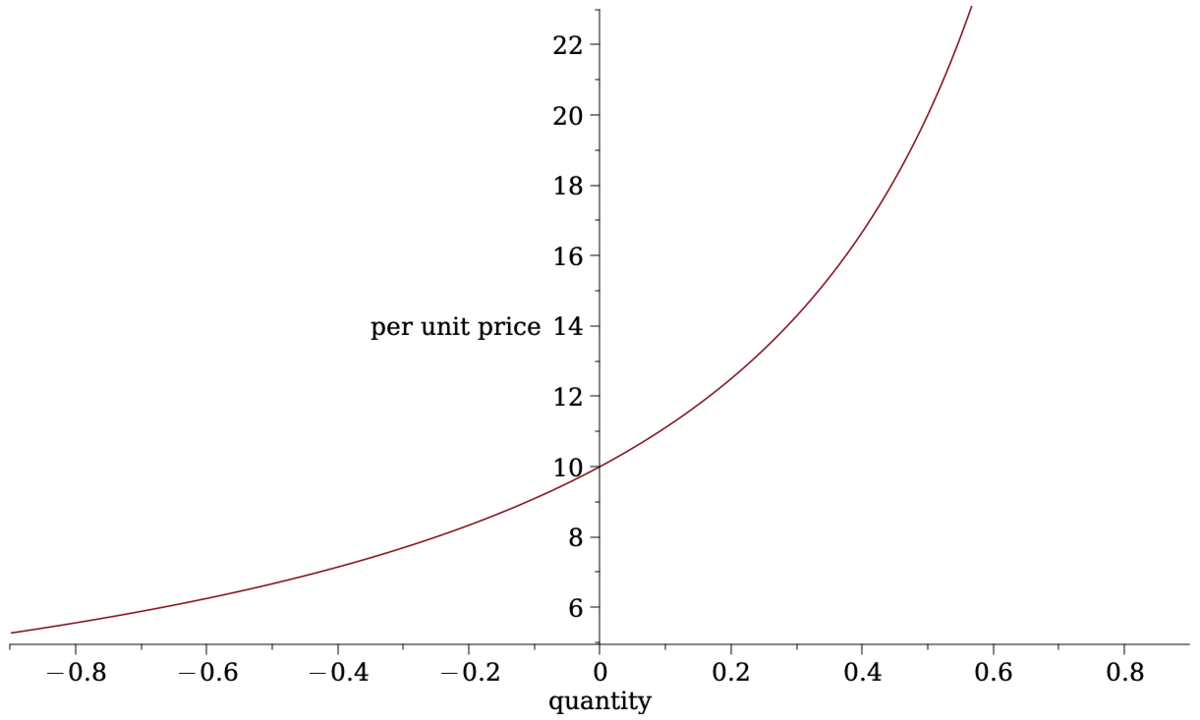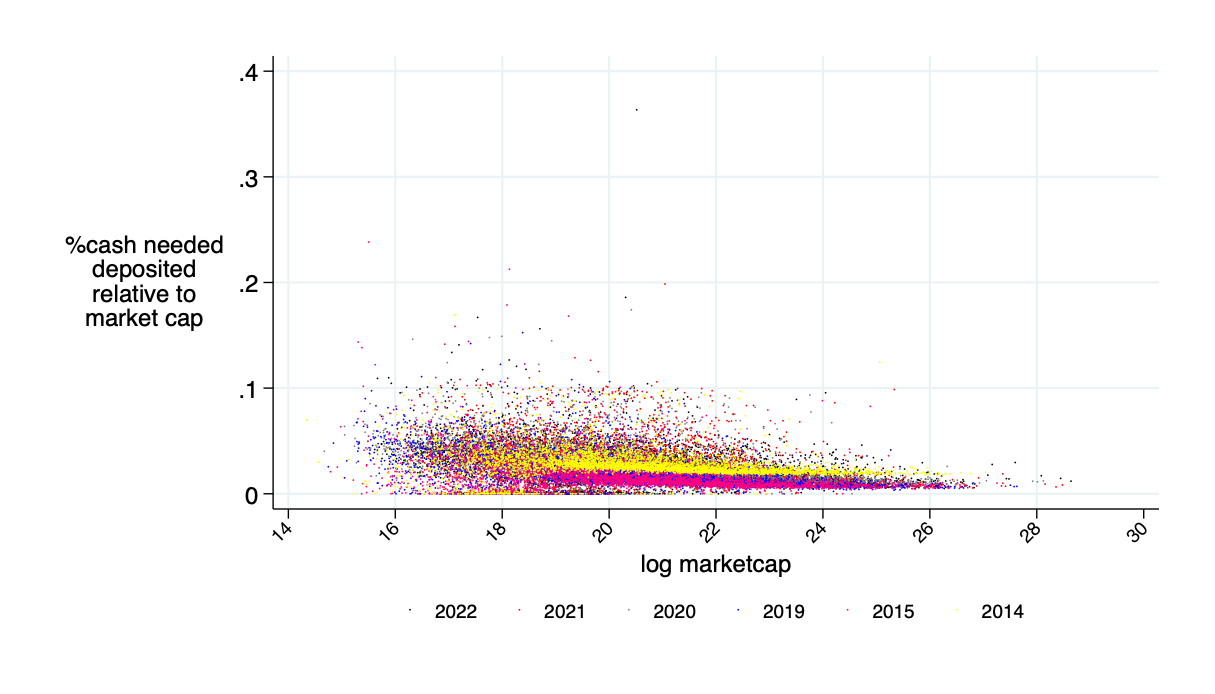Learning from DeFi: Would Automated
Market Makers Improve Equity Trading?
Katya Malinova and Andreas Park
Women in Microstructure
San Francisco, June 25 2023

Preliminaries & Some Motivation
- Blockchain: borderless general purpose value and resource management tool
Basic Idea
- DeFi: financial applications that run on blockchains
- \(\Rightarrow\) brought new ideas and tools
- one new market institution: automated market makers
Decentralized trading with automated market makers (AMM)













AMMs price: mechanical, based on the amount of liquidity deposits.

\[L(a-q,c+\Delta c)=L(a,c)\]
\[a\]
\[a-q\]
\[c+\Delta c\]
\[c\]
Given the initial deposits (a, c), the total cost \(\Delta c\) for \(q\) units is such that:
Remove (buy) \(q\) units of the asset from the pool
Add (pay) \(\Delta c\) cash to the pool
\[a\]
asset (stock)
cash
liquidity after trade \(=\) liquidity before trade


Key Components
- Our question:
- Can an economically viable AMM be designed for current equity markets?
- Would such an AMM improve current markets?
- pooling of liquidity
- pro-rated
- fee income
- risk
- Liquidity providers:
- use existing assets to earn passive (fee) income
- Liquidity demanders:
- predictable price
- continuous trading
- ample liquidity
Liquidity Supply and Demand in an Automated Market Maker

\[(a-q)\cdot(c+\Delta c)=a\cdot c\]
\[a\]
\[a-q\]
\[c+\Delta c\]
\[c\]
- \(\Rightarrow\) Cost of buying \(q\) \[\Delta c=\frac{c}{a-q}\times q\]
- Average price per unit \[p(q)=\frac{c}{a-q}\]
Initial marginal price = initial asset value: \[p(0) =\frac{c}{a}\]
- Average "spread" paid: \[\frac{p(q)}{p(0)}-1=\frac{q}{a-q}.\]
- larger liquidity deposits \(a\) \(\Rightarrow\)
- lower costs for liquidity demanders
Most Common Pricing: Constant Product: \(L(a,c)=a\cdot c\)
Per unit \(p(q)\) as liquidity deposits increase


\[(a-q)\cdot(c+\Delta c)=a\cdot c\]
\[a\]
\[a-q\]
\[c+\Delta c\]
\[c\]
- \(\Rightarrow\) Total cost of trading \(q\) \[\Delta c=\frac{c}{a-q}\times q\]
- Average price per unit \[p(q)=\frac{c}{a-q}\]
Initial marginal price = initial asset value: \[p(0) =\frac{c}{a}\]
Liquidity providers: positional losses
If trade is informed \(\Rightarrow\) new asset value \[=\frac{c+\Delta c}{a-q}>p(q)\]
- larger liquidity deposits \(\Rightarrow\)
- larger positional losses for liquidity providers
- Liquidity providers "undercharge" the informed
Basics of Liquidity Provision in an AMM
\[\underbrace{F p_0 V}_{\text{fees earned on balanced flow}}+\int_0^\infty\underbrace{(\Delta c(q^*)-q^*p_t(R)}_{\text{adverse selection loss when the return is \(R\)}} +\underbrace{F \cdot \Delta c(q^*))}_{\text{fees earned from arbitrageurs}}~\phi(R)dR \ge 0.\]
\(q^* \) is what arbitrageurs trade to move the price to reflect \(R\)
- fundamental value \(\nearrow\)
- \(\Rightarrow\) price \(\nearrow\)
- \(\Rightarrow\) sold the asset for less than its worth
- \(\Rightarrow\) price \(\nearrow\)
- fundamental value \(\searrow\)
- \(\Rightarrow\) price \(\searrow\)
- \(\Rightarrow\) bought the asset for more than its worth
- \(\Rightarrow\) price \(\searrow\)
LP compensation in AMM: liquidity providers earn fees
- must earn more fees on balanced flow than what they lose on price movement
\[\text{fee income} +\underbrace{\text{what LP sold it for}-\text{value of net position}}_{\text{adverse selection loss}} \ge 0 \]
in AMMs:
protocol fee
takes the role of the TradFi bid-ask spread
- a liquidity trade
- arbitrageurs trade back to the original price
- \(\to\) liquidity deposits return to the original values \((a, c)\)
- losses on informed
- no gains (nor losses) on noise
Basics of Liquidity Provision
\[\int_0^\infty\underbrace{(\Delta c(q^*)-q^*p_t(R)}_{\text{adverse selection loss when the return is \(R\)}} +\underbrace{F \cdot \Delta c(q^*))}_{\text{fees earned from arbitrageurs}}~\phi(R)dR +\underbrace{F p_0 V}_{\text{fees earned on balanced flow}}\ge 0\]
\[\frac{1}{\text{initial deposit}}\int_0^\infty(\Delta c(q^*)-q^*p_t(R)+F \cdot \Delta c(q^*))~\phi(R)dR +\frac{F p_0 V}{\text{initial deposit}}\ge 0\]
\[\int_0^\infty\left(\frac{\Delta c(q^*)-q^*p_t(R)}{\text{initial deposit}} +F \cdot \frac{\Delta c(q^*)}{\text{initial deposit}}\right)~\phi(R)dR +\frac{F p_0 V}{\text{initial deposit}}\ge 0\]
closed form functions of \(R\) only
(see Barbon & Ranaldo (2022))
Sidebar: we can quantify how much a PASSIVE LP loses when the price moves by \(R\)

for orientation:
- If the stock price drops by 10% the incremental loss for liquidity providers is 13 basis points on their deposit
- \(\to\) total loss=-10.13%
- If the stock price rises by 10%, the liquidity provider gains 12 basis points less on the deposit
- \(\to\) total gain =9.88%
\[\frac{\text{adverse selection loss when the return is \(R\)}}{\text{initial deposit}}=\sqrt{R}-\frac{1}{2}(R+1)\]
same as in Barbon & Ranaldo (2022)
Liquidity Provision Decision
- Express liquidity provision as a "collective" deposit \(\alpha\) of firm's market cap
- initial deposit \(\alpha \nearrow \) \(\Rightarrow\) LP payoff \(\searrow\)
\[E[\text{IILRAS}(R)]+F\cdot E[\text{another function of }R]+F\cdot \frac{\text{dollar volume}}{\text{initial deposit}}\ge 0.\]
\[\text{what LP sold it for}-\text{value of net position}+\text{fee income} \ge 0 \]
- Competitive liquidity provision
- \(\Rightarrow\) Find \(\alpha\) such that LPs break-even, as a function of
- balanced volume
- asset volatility/return distribution
- fee
Liquidity Demander's Decision & (optimal) AMM Fees
- Wants to trade some quantity \(q\).
- Better off with AMM relative to traditional market if
\[\text{AMM price impact} +\text{AMM fee} \le \text{bid-ask spread}.\]
- Two opposing forces when \(F\nearrow\) for liquidity demand
- more liquidity provision
\(\to\) lower price impact - more fees to pay
- more liquidity provision
- Finding: there exists an optimal (for the liquidity demander) fee \(>0\)
\[F^\pi=\frac{1}{E[|\sqrt{R}-1|/2]+V}\left(-2q\ E[\text{ILLRAS}]+ \sqrt{-2qV\ E[\text{ILLRAS}]}\right).\]
What's next?
- Have:
- equilibrium choices for competitive liquidity provision
- fee that minimizes liquidity demander AMM costs (\(>0\))
- Next:
- Calibrate to stock markets
- Optimal fees?
- AMM Feasible?
- AMM costs at the optimal fee < bid-ask spread?
How we think of the Implementation of an AMM for our Empirical Analysis
Approach: daily AMM deposits
- AMMs close overnight.
- Market: opening auction \(\to\) \(p_0\)
- Determine: optimal fee; submit liquidity \(a,c\)
at ratio \(p_0=c/a\) until break even \(\alpha=\overline{\alpha}\)
- Liquidity locked for day
- At EOD release deposits and fees
- Back to 1.
Background on Data
Special Consideration 1: What volume?
-
some volume may be intermediated
- with AMMs: no need for intermediation
- \(\to\) intermediated volume could disappear
- \(\to\) use volume/2
- Some caveats, e.g.
- arbitrageur volumes
- larger volume if AMM has lower trading costs
Special Consideration 2: What's \(q\) (the representative order size)?
- use average per day
- take long-run average + 2 std of daily averages
- (also avg \(\times 2\),\(\times 4\), depth)
All displayed data CRSP \(\cap\) WRDS
- CRSP for shares outstanding
- WRDS-computed statistics for
- quoted spreads (results similar for effective)
- volume
- open-to-close returns
- average trade sizes, VWAP
- Time horizon: 2014 - March 2022
- Exclude "tick pilot" period (Oct 2016-Oct 2018)
- All common stocks (not ETFs) (~7550).
- Explicitly not cutting by price or size
- All "boundless" numbers are winsorized at 99%.
Special Consideration 3:
Where to get returns and volume?
- Approach 1: "ad hoc"
- "one-day-back" look
- take yesterday's return and volume when deciding on liquidity provision in AMM
- Approach 2: estimate historical return distribution
AMMs based on historical returns

Return distribution example: Microsoft
Return distribution example: Tesla

- average \(F^\pi=11\)bps


Average of the market cap to be deposited for competitive liquidity provision: \(\bar{\alpha}\approx 2\%\)

almost break even on average (average loss 0.2bps \(\approx0\))

average: 94% of days AMM is cheaper than LOB for liq demanders
average savings: 16 bps

average daily: $9.5K

saves around 45% of transaction costs (measured as bid-ask spread)
average annual saving: $2.4 million


implied "excess depth" on AMM relative to the traditional market
Sidebar: Capital Requirement
Deposit Requirements
- Our approach: measure liquidity provision in % of market cap
- Share-based liquidity provision is trivial: the shares are just sitting at brokerages.
- But: AMM requires an off-setting cash amount: \(c =a\cdot p(0)\).
- Cash is not free:
- at 6% annual rate, must pay 2bps per day.
- Would need to add to fees
- But: do we need "all that cash"?
- No.
- (hand-waving argument)
- 2nd gen AMMs have liquidity provision "bands": specify price range for which one supplies liquidity
- Here: specify range for \(R\in(\underline{R},\overline{R})\)
- Outside range: don't trade.
- Inside range: "full" liquidity with constant product formula.
- Implication: only need cash and shares to satisfy in-range liquidity demand.
- For return \(R\), the following number of shares change hands: \[q=a\cdot(1-\sqrt{R^{-1}}).\]
- Fraction of share deposit used \[\frac{q}{a}=1-\sqrt{R^{-1}}.\]
- Fraction of cash used \[\frac{\Delta c ("R")}{c}=\frac{1-\sqrt{R^{-1}}}{\sqrt{R^{-1}}}.\]
- Example for \(R=.9\) (max allowed price drop \(=10\%\)) \[\frac{\Delta c ("R")}{c}=-5\%.\]
- \(\Rightarrow\) "real" cash requirements \(\not=\) deposits
\(\Rightarrow \) Need about 5% of the value of the shares deposited -- not 100% -- to cover up to a 10% return decline

An alternative to -10% circuit breaker:
max cash needed based on long-run past average R \(-\) 2 std
Summary
- AMMs do not require a blockchain - just a concept
- could be run in the existing world (though there are institutional and regulatory barriers)
- Our question:
- Can an economically viable AMM be designed for current equity markets?
- Would such an AMM improve current markets?
- Answers:
- Yes.
- Massively.
- Source of Savings:
- Liquidity providers \(\not=\) Citadel!
- \(\to\) passive liquidity provision
- \(\to\) use idle capital
- \(\to\) + better risk sharing
- pooling of liquidity
- pro-rated
- fee income
- risk
- Liquidity providers:
- use existing assets to earn passive income
- Liquidity demanders:
- predictable price
- continuous trading
- ample liquidity
Optimally Designed AMMs with
"ad hoc" one-day backward look
Optimal fee \(F^\pi\)

average benefits liquidity provider in bps (average=0)
Insight: Theory is OK - LP's about break even

\(\overline{\alpha}\) for \(F=F^\pi\)
Need about 10% of market cap in liquidity deposits to make this work


actually needed cash as fraction of "headline" amount
Only need about 5% of the 10% marketcap amount in cash
AMMs are better on about 85% of trading days

quoted spread minus AMM price impact minus AMM fee (all measured in bps)


relative savings: what fraction of transactions costs would an AMM save? \(\to\) about 30%
theoretical annual savings in transactions costs is about $15B


Literature
AMM Literature: a booming field
- Theory
-
Lehar and Parlour (2021): for many parametric configurations, investors prefer AMMs over the limit order market.
-
Aoyagi and Ito (2021): co-existence of a centralized exchange and an automated market maker; informed traders react non-monotonically to changes in the risky asset’s volatility
-
Capponi and Jia (2021): price volatility \(\to\) welfare of AMM LPs; conditions for a breakdown of liquidity supply in the automated system; more convex pricing \(\to\) lower arbitrage rents & less trading.
-
Capponi, Jia, and Wang (2022): decision problems of validators, traders, and MEV bots under the Flashbots protocol.
-
Park (2021): properties and conceptual challenges for AMM pricing functions
-
Milionis, Moallemi, Roughgarden, and Zhang (2022): dynamic impermanent loss analysis for under constant product pricing.
-
Hasbrouck, Rivera, and Saleh (2022): higher fee \(\Rightarrow\) higher volume
-
-
Empirics:
-
Lehar and Parlour (2021): price discovery better on AMMs
-
Barbon and Ranaldo (2022): compare the liquidity CEX and DEX; argue that DEX prices are less efficient.
-
@katyamalinova
malinovk@mcmaster.ca

slides.com/kmalinova
https://sites.google.com/site/katyamalinova/
@financeUTM
andreas.park@rotman.utoronto.ca

slides.com/ap248
sites.google.com/site/parkandreas/
youtube.com/user/andreaspark2812/